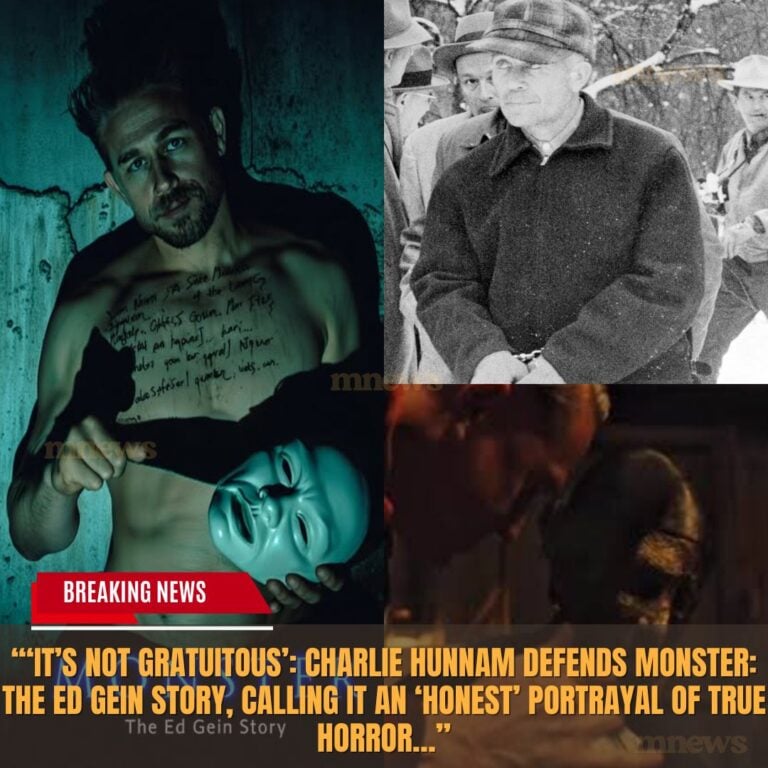The serial killer and necrophile confessed to multiple murders in the late 1960s
:max_bytes(150000):strip_icc():focal(999x273:1001x275):format(webp)/jerry-brudos-ed-gein-split-101025-1a4d651519e646ab9cb0f17d79e72011.jpg)
Ed Gein wasn’t the only serial killer in Monster.
The final episode of the third season of the Netflix anthology series featured real-life murderer Jerome Henry “Jerry” Brudos (played by Happy Anderson). He was dubbed the “Shoe Fetish Slayer” after confessing to killing four women in Oregon in the late 1960s, the Statesman Journal reported.
Brudos got his name for his obsession with women’s feet.
In Monster, the serial killer and known necrophile is interviewed by two FBI agents investigating “The Campus Killer,” who was later identified as Ted Bundy. Though Brudos provided no information regarding their unidentified killer in the fictional meeting, he did praise Gein’s work — a hint that this scene may have only played out in the Plainfield Butcher’s mind.
The season concludes with Brudos visiting Gein in a dream sequence as he’s dying of lung cancer in a mental institution. With him are other notorious killers like Charles Manson and Ed Kemper, a moment creator Ryan Murphy said reflects the far-reaching and unsettling influence Gein’s crimes had on society.
“It was a dark legacy,” he told Tudum in October 2025. “There were many, many dark creatures in our world — Richard Speck, Ted Bundy — who were influenced and obsessed with Ed for all the wrong reasons.”
So, who was Jerry Brudos? Here’s everything to know about the Shoe Fetish Slayer’s life and whether or not he was as tied to Ed Gein in real life as Monster portrayed.
Who was Jerry Brudos?
:max_bytes(150000):strip_icc():focal(604x262:606x264):format(webp)/ralphene-brudos-101025-2f0ed149e7cb4ed79b736e6e8eed479b.jpg)
Brudos was a serial killer and necrophile convicted of murdering three women in the late 1960s at his home in Salem, Ore. According to the Statesman Journal, he pleaded guilty to the murders of Karen Elena Sprinker, Jan Susan Whitney and Linda Dawn Salee in June 1969.
His fourth alleged victim, Linda Slawson, was originally listed as a Jane Doe. Though he confessed to killing and dismembering her body, not enough evidence was found to bring him to trial for her murder, the Statesman Journal reported in 2006.
All four of the women went missing between January 1968 and April 1969. Salee and Sprinker’s bodies were found weighted down in a nearby river in May 1969, the same month Brudos’ home was searched following a tip from a college student.
Inside, police found copper wire, rope and pictures of the missing women. He was arrested and later confessed to raping and killing his victims as well as engaging in necrophilia with their remains.
At the time of his arrest, Brudos was living with his wife, Ralphene Brudos and their two children. Though he maintained that she knew nothing of his crimes, she was charged with first-degree murder in Sprinker’s death in September 1969, per the Corvallis Gazette-Times.
After Ralphene was acquitted, she divorced Brudos.
Did Jerry Brudos really talk to FBI agents about Ted Bundy?
:max_bytes(150000):strip_icc():focal(660x413:662x415):format(webp)/theodore-ted-bundy-court-1978-080625-28792f43bb974503be6b2ee2a67d30a3.jpg)
In Monster, Brudos is interviewed by FBI agents following an abduction and murder committed by still-at-large Bundy. Though there’s no evidence that the exchange happened in real life, the Shoe Fetish Slayer was one of the many serial killers FBI special agent John Douglas interviewed while working for the Behavioral Science Unit.
“He said, ‘John, I have hypoglycemia,’ ” he recalled Brudos saying in a May 2019 interview with Fox News. “‘When I have an attack I can just walk off to this building and kill myself accidentally because I’m just out of my mind.’ “
He explained, “What he’s doing is giving me what you call excuse abuse. That the reason he killed all these women and cut off their foot and took pictures of them wearing high heel shoes is because of this hypoglycemia attack that he would have… If you hear something like that you kind of chuckle and then you’ll say, ‘Wait a minute. I know the case you’re talking about. You didn’t do that.’ ”
There is also no evidence that Brudos knew of or referred to Gein in any way.
What happened to Jerry Brudos?
:max_bytes(150000):strip_icc():focal(739x407:741x409):format(webp)/jerry-brudos-home-101025-96b9c8b63f0a4c53b4a2b80ff71834e0.jpg)
After pleading guilty in 1969, Brudos was handed three consecutive life sentences, per the Statesman Journal. He spent the remainder of his life in the Oregon State Penitentiary, where he appealed for parole multiple times.
In 1995, the Oregon Parole Board told the convicted killer that he would spend the rest of his days behind bars. He died of liver cancer on March 28, 2006, at the age of 67.
“I heard he suffered with his cancer,” Cindi Elliott, Whitney’s sister, told the Statesman Journal in March 2006. “Well, he didn’t make death easy for my sister, for the other girls. I hope eternity is not easy on him.”
Has Jerry Brudos been fictionalized in other works?
:max_bytes(150000):strip_icc():focal(404x317:406x319):format(webp)/jerry-brudos-mindhunter-101025-432a120fdd53453cb868956e36ca8404.jpg)
Yes, in addition to Monster, Brudos was also fictionalized in the 2017 crime drama Mindhunter. The series followed the founding of the FBI’s Behavioral Science Unit in the 1970s and starred Jonathan Groff as an FBI agent loosely based on Douglas.
In Mindhunter, the agent interviews Brudos — played by Anderson in season 1 of the series and in season 3 of Monster — to help develop profiling techniques for catching serial killers.





